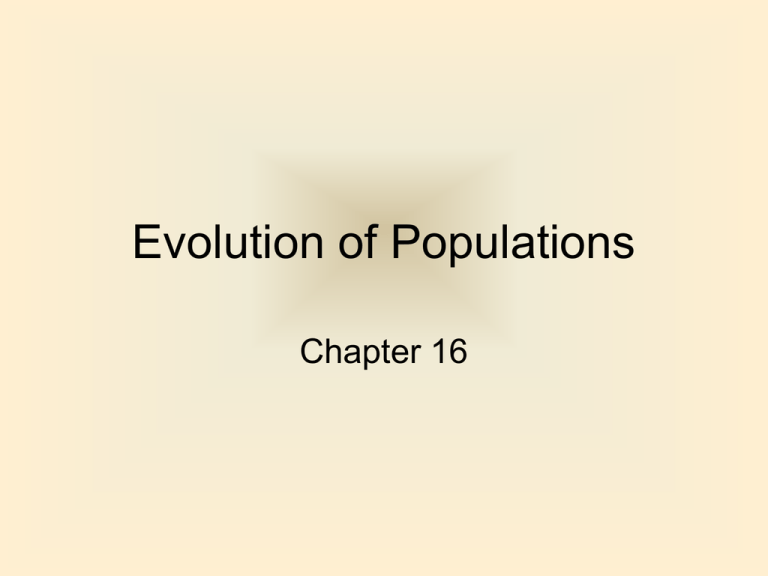1 Chapter 16 Evolution of Populations
advertisement

Evolution of Populations Chapter 16 Genetic Variation • Heterozygotes make up between 4-8% in mammals and 15% in insects. • The gene pool is total of all the alleles in a population. All the genes. • Relative Frequency is the number of times a particular allele appears in a gene pool. • In genetic terms evolution is any change in relative frequency in a gene pool. Relative Frequencies of Alleles Sample Population allele for brown fur 48% heterozygous black 36% homozygous brown Frequency of Alleles allele for black fur 16% homozygous black Brown is the recessive trait but more common in frequency. Sources of Variation • The two main sources for genetic variation are Mutation and Gene Shuffling. • Mutations occur as DNA is changed by mistakes in replication, radiation or chemicals in the environment. • Gene Shuffling occurs as meiosis creates gametes. Crossing Over and Independent Assortment creates new combinations. Single Gene & Polygenic Traits • Single-gene traits are controlled by one gene with two phenotypes. • The variation leads to only two phenotypes. • Polygenic traits are controlled by two or more genes and have variable phenotypes. • The phenotypes usually fall in a bell curve. Frequency of Phenotype Generic Bell Curve for Polygenic Trait Phenotype (height) Natural Selection on Single-gene Traits • Evolutionary fitness can be measured by the ability to reproduce and pass genes. • Natural selection works only on the organism and its phenotype to survive. • Natural selection on a single-gene trait can change gene frequencies and cause evolution. Fig 16-5 • Red, Brown, & Black Lizards Natural Selection on Polygenic Traits • Natural Selection on Polygenic traits is more complex. • Directional Selection: occurs when members on one end of the curve have greater fitness and create a shift in that direction • Stabilizing Selection: the middle of the curve is most fit and the ends shrink. • Disruptive Selection: the lower and upper ends of the curve have greater fitness and the middle declines. Graph of Directional Selection Key Directional Selection Food becomes scarce. Low mortality, high fitness High mortality, low fitness Graph of Stabilizing Selection Stabilizing Selection Key Low mortality, high fitness High mortality, low fitness Birth Weight Selection against both extremes keep curve narrow and in same place. Graph of Disruptive Selection Disruptive Selection Low mortality, high fitness High mortality, low fitness Population splits into two subgroups specializing in different seeds. Beak Size Number of Birds in Population Key Number of Birds in Population Largest and smallest seeds become more common. Beak Size Genetic Drift • In small populations random mating leads to a change in gene frequency called Genetic Drift. • By chance in a small population some organisms might leave more offspring thus increasing their gene frequency. • The founder effect occurs when a new population is created from an existing one and the founding gene frequency is different than the original population due to chance. Genetic Drift Sample of Original Population Descendants Founding Population A Founding Population B Evolution vs. Genetic Equilibrium • Hardy-Weinberg Principle states that allele frequencies will remain in genetic equilibrium and unchanged unless acted upon by evolutionary forces. • There are five conditions for Hardy-Weinberg to work: – – – – – Random mating Very large population No movement in or out of a population No mutations No natural selection Speciation • Speciation is the process of a species evolving into a new species. • Separation of the gene pool is necessary for speciation to occur. – Behavioral Isolation: differences in mating rituals lead to isolation – Geographic Isolation: a population is divided by a geographic boundary. River, mountains – Temporal Isolation: different breeding times separate a population. Concept Map Reproductive Isolation results from Isolating mechanisms which include Behavioral isolation Geographic isolation Temporal isolation produced by produced by produced by Behavioral differences Physical separation Different mating times which result in Independently evolving populations which result in Formation of new species Testing Natural Selection • Peter & Rosemary Grant tested Natural Selection on the Galapagos Islands. • Variation in the Finches followed the bell curve and was genetic. • During drought bigger beaked birds were naturally selected, also a behavior for big beaked birds mating with like birds led to directional selection. • The finches’ beaks became bigger in only a few decades. Speciation in Darwin’s • The species of Galapagos finches evolved by: – Founding population from South America – Separation by geographic boundaries – Changes in gene pool by directional selection – Reproductive Isolation keeps birds separate – Ecological Competition may change the original population – Evolution continues on the islands – Discuss Limits and Questions to finch evolution







